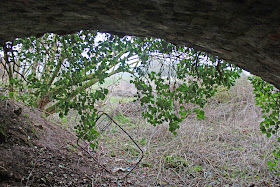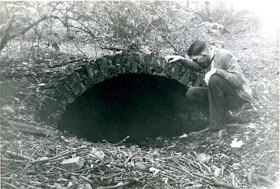Donnington Wood Canal
Pitchcroft Arms (Part 8)
February 2012
Having explored the source of the limestone at the end of the Lilleshall arm, we now turn to the Pitchcroft Arms which extended out to the north to collect the coal from the Pitchcroft and Blackberry Collieries.
Site of four locks from Wilmoor Lane Junction
This whole area is something of a geographic fluke, mapped out in amazing detail by David Adams in his self published study of the area. This small zone bounded by the canals represents an area of intense fracturing which provided a source of accessible coal and limestone.
Line of first arm to quarry just visible to the left heading to the white house
To access the four distinct arms we have to return to Willmoor Bridge which was also the site of the Pitchcroft Junction. From here the canal dipped down through a total of seven locks, and approx 65 feet, to cross the book at the valley bottom. Whilst all trace of the canal has gone, the old maps reveal a series of pounds and even today the hedgerow echoes this wavering line.
Junction with the first Pitchcroft Arm
The first arm bore off to the left after the first four locks in a straight line to a point just north of New House Farm. This channel was cut to remove the overburden from the limestone quarry but was soon abandoned. Whilst the trench has been filled in, a careful inspection of the meadow reveals a slight linear depression, and the junction is marked by a low retaining wall.
Line of Pitchcroft Arm descending to to the brook
The track continues on, marking the course of the canal for a little bit longer. Eventually it curves to the left as it follows the line of the field boundary and approaches the stream en route for Pitchcroft mine. There was another temporary arm heading towards the limestone quarry to the west but no contemporary fingerprints were found. There is no trace of the main Pitchcroft Arm on the ground beyond this point so we picked up the trail from the other side.
Looking back to Lilleshall - the line went between the two big trees - I think!
The remainder of the Pitchcroft Arm is one for the imagination only and has to be viewed with the eye of faith. The old maps tell us that the line contoured round at about 78 metres, grazing Pitchcroft Lane and then continuing on to the site of the Blackberry Bank Colliery. This colliery sat beyond what became a railway line and has since been converted to the A518 Wellington Road. The Pitchcroft mine flooded in 1860 with large quantities of limestone remaining and activity moved to the Blackberry Bank and Wilmoor sites till these became played out and were abandoned in 1882. No mine, no water, no canal.
... and curved round from the tree to the right to the depression in the distance
Considering the size of the Pitchcroft mine, its amazing how little remains to be seen on the ground. All the waste tips have been graded out and the area returned to agricultural use. The only telltale remnant is the pithead which stands in a wooded area at the very centre of the site. In spite of the changes on ground, the contour to the road is just about discernible.
Arm to Pitchcroft Quarry and bricked up bridge
End of the line in Pitchcroft Quarry
This little sub network has one final gem to offer. Way out on the northern extremity there was a 200 yard arm into the Pitchcroft Quarry, but when I say "was" I should really say "is". We consulted the map and followed a footpath to the side of some houses and there, nestling in their gardens was a canal, complete with a dribble of water! We followed this ditch to Pitchcroft Lane and found a bricked up bridge, the canal hole edge still visible under the ivy.
A narrowboat at the end of the canal.....
So that should have been that, but we peered over the north parapet and lo and behold, what should we find but the bows of a modern narrowboat, its front end sitting squarely on the course of a canal abandoned 150 years ago. Its strange to think that this remote point was once connected to the main canal system at Norbury Junction by no less than seven abandoned waterways. (Pitchcroft Arm, Lilleshall Arm, Donnington Wood Canal, Wombridge Canal, Shrewsbury Canal -Trench Arm, Shrewsbury Canal and the Newport Canal).




















































